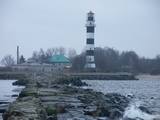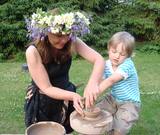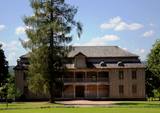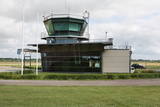| Нo | Название | Описание |
|---|---|---|
|
Zemnieku saimniecība "Mežnoras" Raunā izveidota 1993.gadā. Saimnieki Aivars, Ārija un Līga Urbasti šobrīd audzē 1,6 ha vasaras un rudens avenes, arī nelielās platībās zemenes uz lauka un segtās platībās, siltumnīcā. Zemenes no "Mežnorām" parasti pieejamas laikā no maija vidus līdz oktobra vidum. "Mežnorās " audzē vasaras avenes "Norna", rudens avenes "Babje ļeto", “Polana”, populāro zemeņu šķirni “Polka”. No savā dārzā audzētajām ogām (upenes, jāņogas, ķirši, zemenes u.c.) Aivars gatavo mājas vīnu: "Mežnoru vīns pilnībā sākās Mežnorās. Tas piedzimst nevis mucās, bet sākas mūsu zemeņu vai aveņu laukā, un tās ir daudz dziļākas saknes, kas atstāj pēdas arī garšā”. Saimniecībā audzētais pieejams uz vietas Raunā, gan arī Straupes Lauku labumu tirdziņā, Straupes Hanzas tirgū, arī sezonā - Cēsu tirgū. |
||
|
1,7 km gara lokveida taka, kas iepazīstina ar dažādiem meža biotopiem, to iemītniekiem un meža apsaimniekošanas pamatprincipiem. Apmeklētāju ērtības nolūkā ir izveidotas koka laipas un neliels skatu tornis. |
||
|
Находится на обочине шоссе Лиепая - Вентспилс (P111) около восстановленного деревянного моста через Риву. Интерьер связан с морской тематикой. Осенью через большие окна можно наблюдать за прыгающим лососем за заграждением мельницы. Латышская кухня: Холодный суп, картофель в мундире, жареное филе камбалы и трески, жареная сельдь в облепиховом маринаде, свиное филе с боровиками, купаты с маринованным луком, серый горох с салом, картофельное пюре, слойка из черного хлеба, овсяные хлопья с взбитыми сливкам. |
||
|
Atrodas Kokneses tūrisma centra telpās (1905. gada ielā 7). 160 cm garais un 120 cm augstais makets ir Vittingenas (Vācija) dāvinājums Koknesei, atzīmējot 10 gadu sadraudzības jubileju. Šāda Kokneses pils izskatījās ap 1701. gadu. |
||
|
Западный мол (построен в 1885-м году) простирается в море на 860 метров и вместе с Восточным молом регулирует впадение Даугавы в море, уменьшая ее засорение. В основании гидротехнического сооружения находится сваевая конструкция, укрепленная камнями. Мол многократно реконструировался и укреплялся. В 19-м веке на моле находилась каторжная тюрьма. Примерно половина мола восстановлена путем бетонирования. Остальная часть в данный момент находится в довольно плачевном состоянии! Уже в 1528-м году польский король Стефан Баторий издал приказ о строительстве маяка в устье Даугавы. Первая карта, на которой изображен маяк, датируется 1536-м годом. В учете маяков Российской империи за 1721-й год указано, что здесь находится нагромождение камней, на котором зажигается огонь. Позже были построены деревянные и каменные башни, которые во время войн были уничтожены. Современный Даугавгривский маяк высотой 35 метров был построен в 1957-м году. Огни маяка видны на расстоянии 18 морских миль. |
||
|
Taka ap Ozolu Mazezeru. Purvaino krastu posmā, ap ezera rietumu galu, ierīkotas gājēju laipas. Novērojami purva, meža un ezera augi, dzīvnieki un biotopi. Jūlija beigās īpaši krāšņi zied ūdensrozes. Blakus atrodas Ozolmuiža ar parku.
|
||
|
В 17-18 веках на западный берег Чудского озера пришли бежавшие от гонений в России старообрядцы, для которых была характерна жизнь в длинных, километровых деревнях-улицах. Вдоль побережья Чудского озера располагаются деревни Касепя, Тихеда, Кюкита и Рая - 8-ми километровая полоса длинных деревень тянется до Муствеэ и является одним из немногих мест в Эстонии, где живут старообрядцы. Деревня - улица с уникальными молельными домами и культурным наследием старообрядцев - это прекрасный туристический объект,который подарит Вам много интересных моментов. |
||
|
Умелица из глины, каменной массы и других материалов делает посуду и всевозможные предметы интерьера, обжигая их в печи с открытым огнем. Посетители могут отправиться в познавательную экскурсию, понаблюдать за работой ремесленницы и сами попробовать выточить кружечкус. Приглашает на открытие печи. |
||
|
The distance from Riga to Tallinn is more than 300 km and it takes approx. 5 hours by bus. Therefore we suggest stopping on the way for a brief excursion to a herb farm and lunch in a country pub. This stopover is approx. 1.5 hours’ drive from Riga, just at that point when one needs to stretch one’s legs and enjoy a change of scene. The visit will give an insight in rural life and it may surprise visitors to learn how well Latvians understand nature, knowing and using herbs for food, health and beauty. After the excursion, the group will have lunch in a country pub serving meals made from locally grown ingredients. |
||
|
Кафе Ugandi ‒ это уютное место в самом сердце Отепя, где царит теплая атмосфера, довольство, приятные и чистые вкусы. Войдя сюда, Вы сразу же почувствуете аромат качественного кофе и сладких булочек. Большая витрина переполнена вкусными пирожными ‒ их можно и попробовать на месте, и взять с собой. |
||
|
Just 20km from Valmiera down the river Gauja in Gauja National park theritory we own fabilous place for lovers of leisurely holidays with good active tourism possibilities. Main building with kitchen, shower, WC and higher standard accomodation possibilities. Big shelter with lodges next to it. Big area with fireplace. Sleeping facilities in 2 nd floor and some extra sleeping facilities and big shelter in separate building. There are You can find marked bicycle trail Valmiera-Cēsis next to the CAMP CAUNĪTES. Guests can use canoes for fishing or short tours along the river Gauja. |
||
|
Место, где стояла усадьба Куртувенай, окружено старым парком геометрически-пейзажной планировки. Во второй половине XIX в. парк отличался ландшафтным стилем (т. е. повторял естественный природный ландшафт) с некоторыми элементами геометрической структуры. Территория парка составляет 4,2 га. Здесь до сих пор произрастают старые липы, клены, ясени, дубы, другие декоративные деревья и кустарники — в целом более 20 пород древесных растений |
||
|
National partisans commanded by Rihards Pārups were very active during World War II between Vietalva and Jaunkalsnava. The team was disbanded in 1946. The dugout is at a location that is hard to find and access. It is in the nature reserve of the Veseta Wetlands Swamp. The wood pathway that leads from the East is often hidden by reeds during the summer. During the fierce winter of 2010, the roof of the dugout collapsed, but local enthusiasts plan to reconstruct it. Alongside the dugout is a white cross inscribed with the names of the partisans who lost their lives here.
|
||
|
Тур из Риги в Таллин объединяет природное, культурное и кулинарное наследие и включает в себя прекрасные пейзажи и 15 природных троп, которые пересекают болота, луга и леса вдоль берегов Балтийского моря. Маршрут доставит вас прямо к местным блюдам, чтобы вы могли насладиться свежими и аутентичными блюдами. Вы увидите, как на гриле готовят миногу, и насладитесь такими угощениями, как домашнее мороженое, где они используют яйца от счастливых куриц фермы, копченое мясо с местных ферм и многие другие. В этом туре вы станете настоящим знатоком традиционной и современной латвийской и эстонской кухни. Поскольку фермы, производящие продукты питания, часто расположены в прекрасных природных зонах, вы объедините кулинарный и природный опыт в этом туре. Есть много природных троп, оборудованных смотровыми вышками для наблюдения за птицами. Я нахожу луг возле Айнажи, в котором содержится треть всех видов растений Латвии. Дощатый настил ведет через камыши к смотровой площадке с видом на луг и море. На острове Сааремаа есть множество природных достопримечательностей, которые отличаются от тех, что на материковой части Эстонии. Здесь есть доломитовые скалы, вересковые пустоши, метеоритное озеро и скалистый морской берег. Тур проходит по сельским хозяйствам и традиционным деревням, типичным для прибрежных районов. Остров Хийумаа - это спокойное место, в котором царит особая эстонская атмосфера. Здесь есть важный птичий заповедник в бухте Кяйна, необычная береговая линия, а также несколько небольших островков у юго-восточного побережья. Вернувшись на материк, полуостров Палдиски дает представление о недавней истории своей бывшей советской военной базы. |
||
|
И теперешний Вентспилский аэродром, как в свое время объект военного значения, используется в качестве военного аэродрома. В настоящее время регулярные пассажирские рейсы в Ригу прерваны, а аэродром используется для нужд малой авиации.
|
||
|
Старый дворец господской усадьбы, который находится на краю улицы Графов Платеров - на берегу Яунупите, построен в 1759 году (барокко, веницианский архитектор Антонио Парако). Позже его перестроили и после постройки нового дворца на первом этаже здания находилась летняя резиденция рода Платеров, а на втором и третьем этаже находилась библиотека (погибла во время Первой мировой войны), в которой располагалось примерно 20 тысяч книг. Строительство нового дворца Краславской господской усадьбы (в верхней части берега долины Даугавы) началось в 1765 году (архитектор Доменико Парако), первоначально барокко, а на рубеже XVIII –XIX вв. перестроен в стиле классицизма. В здании обнаружена уникальная живопись стен стиля рококо с видами Рима, которая по аналогам замков Польши создавалась в 60 - 70 годах XVIII века. Недавно проведены объемные работы по реновации фасада дворца, и тот приобрел ухоженный вид. Дворец опоясывает созданный в середине XVIII века романтический пейзажный парк - парк Графов Платеров с восстановленным искусственным гротом и львом. Рядом с новым дворцом находится Краславский историко-художественный музей. |
||
|
В Ошвалки – населенном месте между Юркалне и Сарнате установлен памятный знак «Парус надежды», посвященный тем латышским беженцам (1944 – 1945), которые на рыбацких лодках отправились через Балтийское море в Швецию. Знак установлен на прибрежной дюне между дорогой и морем. |
||
|
Old Kybyn Inn in Trakai serves traditional Lithuanian food like their Karaite meat pasty – the Kybyn as well as other sorts of food. |
||
|
Создает красивые работы в черной (окуренной) технике. Посетители могут присесть к гончарному кругу и поучаствовать в открытии печи. Заказ и приобретение керамических работ. Параллельно можно осмотреть декоративный сад и получить услуги флористки. |
||
|
В хозяйстве зеленеет богатейший яблоневый сад, а в поле растет картофель и клубника. Можно купить яблоки и попробовать клубнику. |
||
























